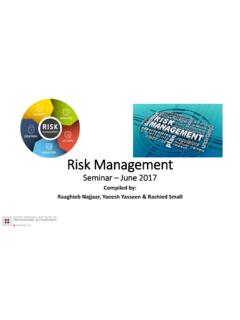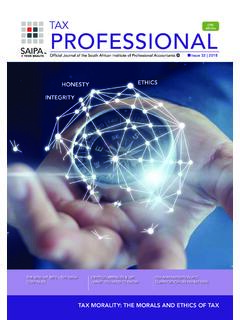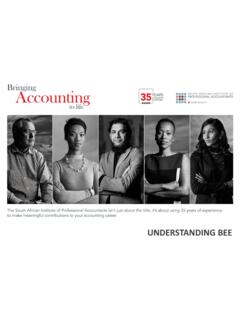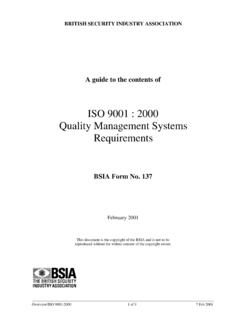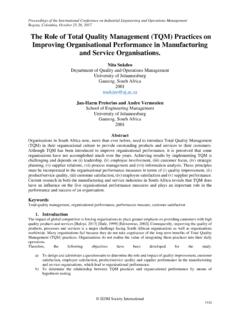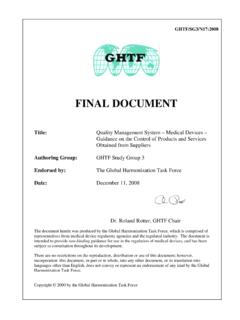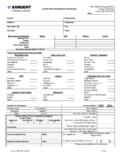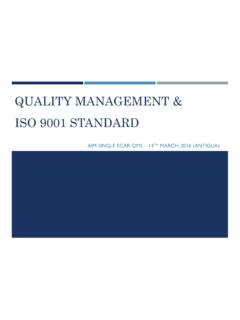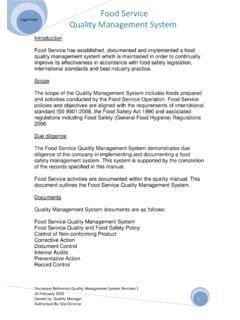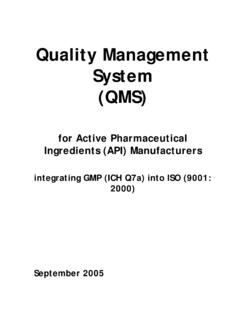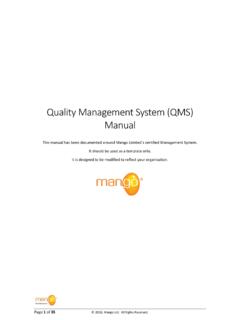Transcription of PRACTICE MANAGEMENT - QUALITY CONTROL MANUAL …
1 PRACTICE MANAGEMENT - QUALITY CONTROL MANUAL (ISQC 1)1 PRACTICE MANAGEMENTQ uality CONTROL MANUAL (ISQC 1)CPD PractitionersApril 2018 PRACTICE MANAGEMENT - QUALITY CONTROL MANUAL (ISQC 1)2 QUALITY -DefinitionPRACTICE MANAGEMENT - QUALITY CONTROL MANUAL (ISQC 1)3 QUALITY -DefinitionQuality has various definitions and interpretations the following are but a selected few: QUALITY is a perception QUALITY is not a number QUALITY is about meeting and/or exceeding expectations QUALITY is conformance to standards QUALITY is rendering value for money services/goods QUALITY is a product or service is not what the supplier puts in. It is what the customer gets out and is willing to pay Peter DruckerPRACTICE MANAGEMENT - QUALITY CONTROL MANUAL (ISQC 1)4 QUALITY Assurance vs QUALITY ControlQuality Assurance.
2 Involves the continuous monitoring & evaluation throughout the process process checklists or audits Is a preventative strategy implemented to minimize risks Professionals are able to determine whether the engagement deliverables are acceptable based on the procedures applied to create it reviewing the work performed to draft the financial statements for compliance to IFRS for SMEsPRACTICE MANAGEMENT - QUALITY CONTROL MANUAL (ISQC 1)5 QUALITY Assurance vs QUALITY ControlQuality CONTROL : Involves the process of evaluating the end result / products focus on the output Is a detection strategy implemented to identify risks or non-conformance Professionals are not able to determine whether the engagement deliverables are acceptable checking financial statements for compliance to IFRS for SMEsPRACTICE MANAGEMENT - QUALITY CONTROL MANUAL (ISQC 1)6 QUALITY MANAGEMENT QUALITY MANAGEMENT is the system, procedures, methods and techniques that an organisation / PRACTICE implement to ensure that the requirements and standards place on it met.
3 QUALITY MANAGEMENT system includes both QUALITY assurance and QUALITY CONTROL processes ISQC 1 QUALITY CONTROL Standard outline the key areas that should be included in a QUALITY MANAGEMENT SystemPRACTICE MANAGEMENT - QUALITY CONTROL MANUAL (ISQC 1)7 ISQC 1 -OverviewPRACTICE MANAGEMENT - QUALITY CONTROL MANUAL (ISQC 1)8 QUALITY CONTROL ManualStaff -Compliance with: Professional Standards & Regulations Competent & Experienced for the engagementEngagement Compliance with: Engagement Standard & Procedures Ethical & Professional ConductReports Appropriate for: For the engagement Comply with Engagement StandardPRACTICE MANAGEMENT - QUALITY CONTROL MANUAL (ISQC 1)9 QUALITY CONTROL ManualPRACTICE MANAGEMENT - QUALITY CONTROL MANUAL (ISQC 1)10 Code of Conduct1.
4 Integrity2. Objectivity3. Due care4. Confidentiality5. ConductCode of Ethics1. Public Interest2. Behaviour3. Ethical dilemma4. ReportingEngagement:1. Standards2. Procedures3. ReportsQuality CONTROL ManualPRACTICE MANAGEMENT - QUALITY CONTROL MANUAL (ISQC 1)11 Practitioner s QUALITY CONTROL objective QUALITY of service delivery Engagement objective compliance with engagement standardsFinancial statement objective fair representation and reliability Regulatory objective compliance, conduct and reporting (NOCLAR) QUALITY CONTROL ManualPRACTICE MANAGEMENT - QUALITY CONTROL MANUAL (ISQC 1)12 Documentation policies & procedures to ensure compliance with internal process & professional standardsComponents comply with ISQC 1 where relevant and appropriateEngagements procedures and supporting documentation (working papers)Communication staff awareness and training as well as notification of changesLeadership -OverviewPRACTICE MANAGEMENT - QUALITY CONTROL MANUAL (ISQC 1)13 LeadershipQualityCommitmentInternal cultureProfessional values & attitudeLeadership StructurePRACTICE MANAGEMENT - QUALITY CONTROL MANUAL (ISQC 1)14 Principal:Ultimate responsibility for qualityQuality CONTROL Officer.
5 Operational responsibility for the QUALITY CONTROL systemEngagement Partner:Responsible for the execution of the engagement in terms of the QUALITY CONTROL manualLeadership Internal CulturePRACTICE MANAGEMENT - QUALITY CONTROL MANUAL (ISQC 1)15 Commitment to QUALITY importance of QUALITY throughout the organisation & all staffPolicies & procedures performance evaluation and promotion linked to qualityResponsibility commercial consideration should not override QUALITY of work performedInvestment allocation of resources for the development, documentation & support of QUALITY MANAGEMENT systemsLeadership -ResponsibilitiesPRACTICE MANAGEMENT - QUALITY CONTROL MANUAL (ISQC 1)
6 16 QUALITY ControlResponsibility of all staff at all levelsTraining is keyQuality is not compromisedApply procedures consistentlyAllocation of resourcesLeadership QUALITY CONTROL OfficerAppointment criteria: Experience in QUALITY CONTROL Specialist knowledge in QUALITY CONTROL QUALITY CONTROL for industries Business & professional ethics Authority within the PRACTICE Application of ISQC 1 Risk consideration: Involvement in engagement team Involvement in monitoring process Involvement in QUALITY ReviewsPRACTICE MANAGEMENT - QUALITY CONTROL MANUAL (ISQC 1)17 Leadership QUALITY CONTROL OfficerResponsibilities: Changes in professional standards Review of QUALITY CONTROL systems Compliance to QUALITY CONTROL systems Risk associated with engagements Improve QUALITY CONTROL systemsLeadership: Communication & distribution of QUALITY CONTROL processes Conducting training of staff Conducting induction of staffPRACTICE MANAGEMENT - QUALITY CONTROL MANUAL (ISQC 1)18 Leadership QUALITY CONTROL OfficerEthics: Staff training on Code of Ethics Maintain a register of threats to independence Maintain a register of threats to engagement standards Procedures to identify and report ethical dilemmas Maintain a register of clients risksEngagement performance.
7 Compliance to professional standards Maintain performance review reportsPRACTICE MANAGEMENT - QUALITY CONTROL MANUAL (ISQC 1)19 Planning MeetingPRACTICE MANAGEMENT - QUALITY CONTROL MANUAL (ISQC 1)20 QUALITY CONTROL SystemsEthics & Professional ConductIndependence & Conflict of InterestEngagement StandardsReportingRelevant Ethical RequirementsPRACTICE MANAGEMENT - QUALITY CONTROL MANUAL (ISQC 1)21 Ethical RequirementsPublic InterestAttitude & Ethical behaviourProfessional judgementEthical PrinciplesRelevant Ethical RequirementsPRACTICE MANAGEMENT - QUALITY CONTROL MANUAL (ISQC 1)22 Self-interest threatsSelf-review threatsAdvocacy threatsFamiliarity threatsIntimidation threatsRelevant Ethical RequirementsPRACTICE MANAGEMENT - QUALITY CONTROL MANUAL (ISQC 1)23 Ethical RequirementsCompliance to IEASBC ompliance to independenceThreats to ethicsReporting of ethical dilemmasInvestigation of ethical issuesActions for non-complianceAcceptance & ContinuanceRelationships between clients and professional accountants are often established over several years.
8 Provide high- QUALITY client service compromising situation -continued business association may need to be reconsideredPolicies with respect to acceptance and continuance of client relationships be linked with independence considerations. PRACTICE MANAGEMENT - QUALITY CONTROL MANUAL (ISQC 1)24 Acceptance & ContinuancePRACTICE MANAGEMENT - QUALITY CONTROL MANUAL (ISQC 1)25 Competence: staff assigned to the engagement are competent and have the relevant knowledge & experienceResources: PRACTICE has the resources (staff, time and other) to execute the engagementEthics: ability to comply with the ethical and independence requirementsRisk: consider the risk of the client (integrity) and its fit with the PRACTICE s risk profileAcceptance & ContinuancePRACTICE MANAGEMENT - QUALITY CONTROL MANUAL (ISQC 1)26 Continuance:1.
9 Prior findings2. Changes3. Payment4. Risk/reputation5. Staff turnoverNew client:1. Risk assessment2. Risk profile fit3. Engagement4. Resources5. ExpectationsEngagement:1. Nature & type2. Risk3. Competence4. Use of reports5. DistributionContinuance of EngagementPRACTICE MANAGEMENT - QUALITY CONTROL MANUAL (ISQC 1)27 Findings: assess the type & nature of findings in terms of risks and MANAGEMENT s response to addressing itChanges in business: assess the changes in terms of its risks on & competence requires for the engagement Financial status: assess the ability of the client to meet its financial obligations for the engagementConflict of interest.
10 Assess conflict of interest, independence & ethical considerationsAcceptance of New ClientsPRACTICE MANAGEMENT - QUALITY CONTROL MANUAL (ISQC 1)28 Previous professional practitionerClient s risk assessRisk profile fit of practiceConflict of interest & independenceEngagement risk assessmentAcceptance of New EngagementsPRACTICE MANAGEMENT - QUALITY CONTROL MANUAL (ISQC 1)29 Previous professional practitionerEngagement risks assessmentConflict of interest & independenceCompetence & resource requirementsRegulatory considerationsHuman ResourcesThe PRACTICE require sufficient employees with the capabilities, competence, and commitment to ethical principles necessary to perform engagements in accordance with professional standards and regulatory and legal requirements, so as to enable the professional practitioner to issue reports that are appropriate in the circumstances.
